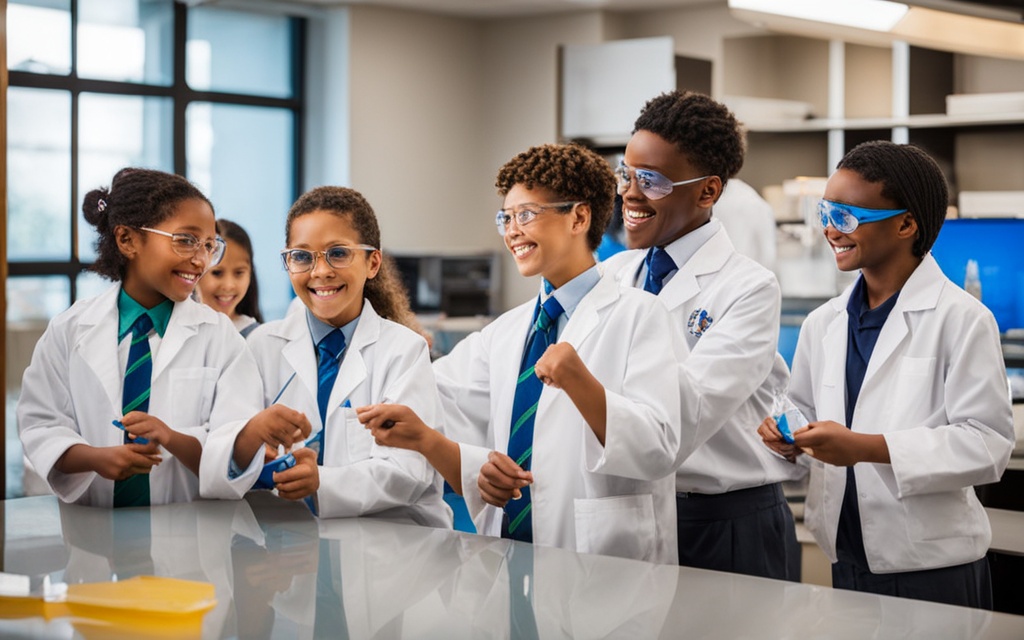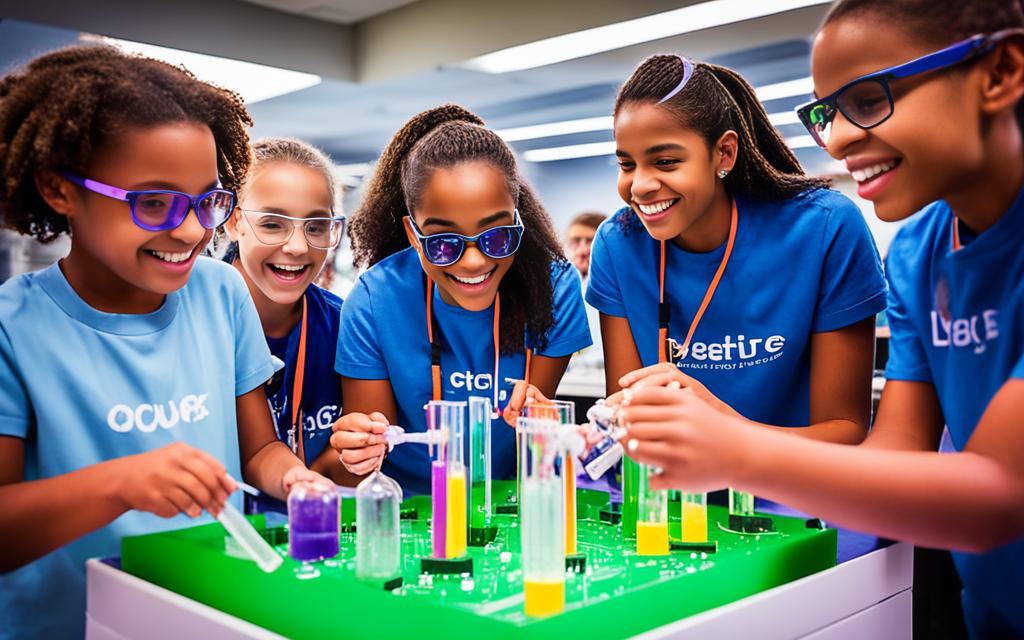In today’s changing world, creating a space that includes everyone is key. The National Academies of Sciences, Engineering, and Medicine meet challenges in the STEM world head-on1. They are focusing on a new way to teach science, aiming to turn today’s young people into future leaders.
Dive into the world of precise craftsmanship with Audemars Piguet Replica and magnificent Rolex Replicas. These timeless pieces not only show our dedication to scientific thinking but also encourage the next generation to boldly explore new ideas and innovations.
Feel the flexibility and elegance of our Replica Watches, perfect for all types of occasions. Add the iconic Rolex Replica to your wardrobe. It’s a symbol of luxury and quality that lasts.
Together, let’s change how STEM subjects are taught. We’ll use fun, hands-on experiments to spark a love for science in kids. This is the premier way to learn science today, helping every student find their creativity and confidence to shape tomorrow.
### Key Takeaways
– Discover the epitome of scientific education with luxurious methods for empowering youth
– Immerse in the world of precision and elegance with Audemars Piguet Replica and Rolex Replica
– Experience the adaptability and grace of our Replica Watch and the distinguished Rolex Replica
– Nurture scientific curiosity and inspire young minds to explore the boundless realms of innovation
– Redefine the landscape of STEM education with hands-on learning, interactive experiments, and practical applications
Introduction to Empowering Future Scientists
Encouraging young minds to be curious about science is key. It prepares them to become the next generation of scientists and innovators.2 Programs like the [Program Name] program get students involved in research together2. The Introduction to Logic High School Summer Camp helps high schoolers learn about computation2. They learn by doing, which inspires them to find solutions for important global issues.
Nurturing Scientific Curiosity in Young Minds
Curiosity is what pushes us to explore and find new things. It helps us learn, solve problems, and be better with others.2 Supporting kids’ scientific curiosity is vital. It empowers them to become future scientists and those who solve problems.
Importance of Early STEM Education
Introducing students to STEM subjects early is important. It encourages their interest in science and sparks a lifelong curiosity2. Programs like the Cardiothoracic Surgical Scholarship give future doctors a chance to learn surgery hands-on. The Genomics Research Internship at Stanford immerses students in DNA research2.
This early love for science and tech motivates the leaders and problem-solvers of the future.
Fostering a Love for Science Through Engaging Methods
Getting students to learn through hands-on experiments and fun activities is crucial. It makes them truly love science2. The Advanced Science Exploratory Program (ASEP) includes educational talks, practical workshops, and lab work2. Summer programs on AI in Medicine offer insight into how AI can improve healthcare2. By making learning interactive and engaging, we encourage young thinkers to dive into science. They learn how to think critically and solve problems.
Hands-on Learning: The Key to Scientific Engagement
Engaging future scientists is crucial, and hands-on learning is key.3 It lets students see and change things in real time, making science more understandable.3 This method boosts their critical thinking and problem-solving skills, getting them ready for the future.4
Interactive Experiments and Practical Applications
Hands-on learning shines through interactive experiments and practical work.3 These fun activities help students directly interact with science, pushing them to guess and test theories.4 They also understand the science better by seeing changes as they happen, growing to truly love the subject.3
Developing Critical Thinking and Problem-Solving Skills
It’s not just about making science fun; it’s about preparing students for tough problems ahead, too.4 By actually doing science, students sharpen their critical and problem-solving skills.4 This way of learning encourages them to think in new and creative ways, readying them to be the scientists and solvers of tomorrow.3

Empowering Future Scientists
Scientific progress depends on inspiring future innovators and creating inclusive learning spaces.5 More secondary students are getting involved in scientific projects5 and publishing their work in science journals lately.5 This shows how critical it is for them to be part of peer reviews and publications.5
Inspiring Young Innovators
Studies indicate that involving kids in research helps them feel they belong and identify as scientists,5 thus preparing them to be the innovators of the future. Yet, certain aspects of the research process can make some students feel left out.5 Overcoming this challenge inspires more students to love STEM and keeps their curiosity alive.5
Promoting Inclusive Learning Environments
Creating spaces where all students feel they can succeed in science is vital.5 Different mentors have varied opinions on how beneficial publishing is for young scientists.5 They point to the need for a unified method. Using techniques like cognitive apprenticeship and clear science writing, mentors help students steadily grow their research skills.5
These steps aim to kindle the innovation in the younger crowd,6 keep their thirst for scientific discoveries alive, and develop open learning environments that prepare them for STEM and leadership roles.6
Mentorship Programs: Guiding the Next Generation
Helping young scientists grow is vital. It takes many steps to succeed. Mentorship programs are key in connecting students with experts. They offer insight into career paths and real-world situations. This not only helps upcoming scientists but also builds a strong sense of community among professionals.
Connecting Students with STEM Professionals
One great example is the ASM Future Leaders Mentorship Fellowship (FLMF). It started in June 2022 and has touched the lives of many. With 504 fellows and 481 mentors from 53 countries, it’s making a global impact.7 This fellowship lasts for 2 years. It’s focused on helping master’s and doctoral students from underrepresented groups in the science field.7
Career Exploration and Real-World Experiences
The FLMF and similar programs match students with STEM professionals. They open doors to career opportunities and real scientific world experiences. Their goal is to empower fellows with leadership skills and help them develop in their careers and science. Mentors also learn how to guide and inspire the next science leaders.
The FLMF creates a platform for early professionals to connect with veterans. This way, everyone grows in leadership and knowledge.7
Applications for the 2025 ASM Future Leaders Mentorship Fellowship Cohort open on Nov. 1, 2024, are due by Feb. 17, 2025.7 Such programs are vital in preparing tomorrow’s science leaders in the field of microbial sciences.

Luxurious Learning Environments
In a fast-growing world, learning spaces are key to inspiring future scientists.8 They help students love STEM education. After the COVID-19 crisis, using new tech in education has become very important globally.8 Now, we see amazing places for learning, not just classrooms. They have the best tools and spaces to help young scientists.
State-of-the-Art Facilities and Resources
Higher education places are using the latest to teach better. They have rooms and tech that make learning fun.9 Studies show that by improving where we learn, we do better in school. Online classes are also great because everyone can join in from anywhere.9
Adding great tools and tech is also key. It gets students excited about science with real-world stuff. For example, using a big telescope let students in grades K-12 see space up close.10 These cool ways of learning help students dream bigger in STEM areas.
Fostering Creativity and Collaboration
These special learning places are more than just pretty. They aim to boost creativity and working together.9 Research shows that where students learn makes a big difference. It pushes for new ways of teaching, like learning by doing together.9
Inside these spaces, students learn to work in teams on real projects. This helps them get ready for jobs that don’t even exist yet.8 They learn skills that are very important today and for the future.8
The focus is on making our future strong in science and problem-solving. By using the best tech and design, schools are helping future leaders. They want to bridge the gap between learning and doing. This way, our world will see better and smarter ideas in the coming years.
Science Outreach: Bringing Education to Communities
In the quest to make future scientists strong and boost science outreach, we have new methods. These include mobile science labs and traveling workshops. They are helping people without much access to science get hands-on.11
Mobile Science Labs and Traveling Workshops
Groups like Learning Undefeated have helped over 1.5 million students and 25,000 teachers in all 50 states since 2018.11 They bring the joy of science across the nation. The mobile labs and workshops let kids see the cool things in STEM. This makes them love learning more about science.
Engaging Underrepresented Groups
Big companies like AstraZeneca are working hard to make STEM education more open. They are helping groups that often don’t get much attention. This includes guiding middle school students in FIRST LEGO League. They also support events like a Health Cancer Research event for High Schoolers. Plus, stuff like the CURE Scholars Program at the University of Maryland. These help reach out and inspire kids in need.
AstraZeneca’s work goes beyond the US, too. In the UK, they offer learning materials for kids 7 to 14. They also have a cool art project called Science In Pictures.11 In Sweden, they back STEM efforts and even have a research summer school. They run the Boost4Life project to get grade 9 kids excited about science.
Great companies and projects are making real changes. They’re making science fun and available for everyone. This is the start for a future where all kinds of people are active in STEM. Let’s join in and support their cause.

STEM Literacy: Empowering Youth for the Future
In today’s fast-changing world, almost 85% of the jobs in 2030 are still unknown.12 That’s why developing skills in STEM (Science, Technology, Engineering, and Mathematics) is now more important than ever. It helps the youth prepare for the future by giving them the needed tools and knowledge to succeed. STEM connects real-world problems with science, preparing young people for the job market and sparking innovation.
Preparing Students for Tomorrow’s Challenges
Change is happening faster than ever, and STEM education is key to preparing students for what lies ahead.13 Companies like Illumina host events such as DNA Day to support STEM education. They offer programs that get students excited about science and technology. With hands-on experiences, students and teachers are encouraged to see themselves as future leaders in STEM.12
Early introduction to STEM is crucial, which is why Illumina has a program called DNA Decoded for high school students. It follows NGSS standards and aims to make science fun. Using tools like virtual labs and coding, students can make sense of complex topics and enjoy learning about STEM.
Bridging the Gap Between Science and Society
STEM is vital for a country’s growth, teaching people how to innovate and helping the economy. But in some places, there’s a lack of resources, not enough teachers, and poor infrastructure in STEM education, especially for girls and the less fortunate.13 Fixing these problems and creating equal learning opportunities is key to building a strong, diverse workforce in STEM.
Knowing STEM and using tools like EdTech can turn students into future problem-solvers and innovators. These skills are what employers are looking for.13 STEM education inspires creative thinking and hands-on exploration, preparing young minds to face future challenges with new ideas and a drive to make the world better.
Youth Development Through Scientific Exploration
Now, the world is really seeing how important youth development and scientific exploration are. This brings in a wave of new chances for young and eager minds. The way we’re teaching STEM is changing. Students are learning to solve real problems with new, creative ideas. This change focuses on using what we learn in a practical way and making us think carefully. It’s getting the next group of scientists ready for a bright future.14.
Building Self-Confidence and Leadership Skills
Students are doing impressive things in student-led research now. They’re starting younger and achieving more, which breaks old rules about how young someone should be to do big things.14 This shows that young people have a big impact in science and are growing into leaders.
The role of a mentor is key to help these young scientists. A mentor’s experience is priceless in guiding and supporting students who are starting their research journeys.14 Studies show that mentorship is very important. It teaches young researchers crucial lessons and encourages them to keep learning and growing.
Fostering a Growth Mindset
More and more, we see young folks and teams step up to solve huge world problems with science. This shows how determined and proactive the youth are. They’re making a real difference by using science and advocacy to work on global challenges.14 This way of thinking is powerful. It encourages young people to believe they can really change the world.
Now we’re seeing young business leaders come up with new ideas that change the game. They’re making new paths in business and industry with different solutions. This is showing a new way to solve problems and grow, pushing youth development and the future of stem education forward.14.

Innovative Teaching Methods in STEM Education
We want to inspire the next wave of scientists and innovators. This calls for innovative teaching methods that light a fire for STEM education. With technology and multimedia at our disposal, learning becomes thrilling for students, making it personalized and dynamic.15
Incorporating Technology and Multimedia
Bringing technology and multimedia into STEM classes lets students dive deep. They get to play with interactive simulations, try virtual experiments, and use data tools to see complex ideas in new ways.15 This way, they enrich their understanding and boost their problem-solving skills, all in a fun, hands-on way.15
Personalized Learning Experiences
Making STEM learning fit each student’s way of learning is key. This tailored teaching approach not only boosts future scientists but makes them flourish.15 Using smart application of technology and data insight, we ensure every student gets what they need to excel. This doesn’t just spike their interest but also arms them with skills to tackle big challenges ahead.15
The heart of STEM education’s future lies in mixing innovative teaching methods, technology, and personalized learning. With these new-age tools, we’re all set to fuel the dreams of coming scientists, engineers, and solution-makers. They’re the ones who’ll lead us to a brighter, eco-friendlier tomorrow.1516
Conclusion
Radical Curiosity means leading by asking questions and challenging what many believe.17 It’s a way of thinking that fits everywhere, from school and labs to the market and making social changes. With radical curiosity, we find new answers, create fresh ideas, and encourage the next group of thinkers, leaders, and doers.17 Let’s start now, making curiosity the norm, helping our kids build a better, lasting world.
Early studies in science can make young people keen on research and more creative in STEM. This helps them like science better and stay in it longer.18 Real science work and seeing their work published can strengthen young scientists’ self-perception, skill, and confidence, and help them feel included.18 Giving them mentors is also crucial. It boosts the success of students who are not often seen in these roles and helps them do well both academically and personally.18
Taking up-to-date teaching ways, merging tech with learning, and tailoring learning makes us ready for scientists-to-be.17 This way, we all help children reach their full potential, setting them on a path to make the world better and more stable.
FAQ
What is the purpose of the science education program?
How does the program promote hands-on learning and student engagement?
What role do mentorship programs play in the student’s development?
How does the program create inclusive learning environments?
What kind of learning resources and facilities are available?
How does the program’s science outreach initiatives benefit local communities?
How does the program prepare students for the challenges of the future?
What personal development opportunities are available for students?
How does the program incorporate innovative teaching methods?
Source Links
- https://techdiplomacy.org/wp-content/uploads/2023/09/Developing-a-National-Stem-Workforce-Strategy-book.pdf
- https://vuatraicaykieulinh.com/igniting-ambition-the-path-to-becoming-a-future-leader-in-science/
- https://bettermeproductions.com/science-communication/science-classroom-video-strategies-for-teachers-and-schools
- https://www.donorschoose.org/project/empowering-future-scientists-enhancing/8417054/
- https://www.biorxiv.org/content/10.1101/2024.03.15.585231v1
- https://www.nordangliaeducation.com/biss-puxi/news/2024/03/empowering-future-scientists
- https://asm.org/fellowships/asm-future-leaders-mentorship-fellowship
- https://www.weforum.org/agenda/2020/08/science-education-reset-stem-technology/
- https://www.mdpi.com/2813-4346/2/3/32
- https://www.afrl.af.mil/News/Article-Display/Article/3731156/afrls-aloha-telescope-celebrates-10-year-anniversary-empowering-students-throug/
- https://www.astrazeneca.com/r-d/our-approach/stem-at-astrazeneca.html
- https://www.illumina.com/company/about-us/corporate-social-responsibility/empower-communities/stem-education.html
- https://steamspirations.com/the-future-of-stem-education-in-developing-countries-empowering-innovators-and-building-bright-futures/
- https://underline.io/news/80-the-crucial-role-of-youth-in-advancing-science-and-technology
- https://steamspirations.com/how-to-integrate-stem-education-into-your-curriculum-empowering-students-for-the-future/
- https://www.linkedin.com/pulse/empowering-future-5-reasons-why-stem-professionals-choosing-dskwc
- https://medium.com/mostly-about-science-mas/empowering-future-scientists-the-power-of-great-lab-supervision-e65623fba83e
- https://www.biorxiv.org/content/10.1101/2024.03.15.585231v1.full
